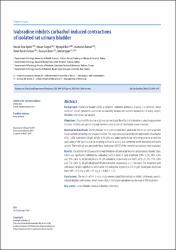Ivabradine inhibits carbachol-induced contractions of isolated rat urinary bladder

View/
Access
info:eu-repo/semantics/openAccessDate
2018Author
Aydın, Hasan RızaTurgut, Hasan
Kurt, Ayşegül
Şahan, Ramazan
Kalkan, Ömer Faruk
Eren, Hüseyin
Ayar, Ahmet
Metadata
Show full item recordCitation
Aydin, H. R., Turgut, H., Kurt, A., Sahan, R., Kalkan, Ö. F., Eren, H., & Ayar, A. (2018). Ivabradine inhibits carbachol-induced contractions of isolated rat urinary bladder. Advances in clinical and experimental medicine : official organ Wroclaw Medical University, 27(7), 893–897. https://doi.org/10.17219/acem/71197Abstract
Background. Overactive bladdei (OAB), a symptom syndrome defined as urgency, is a common clinical condition, which sometimes cannot be satisfactorily treated with current medications in every subject; therefoie, alternatives are needed. Objectives. the aim of this in vitro study was to investigate the effects of ivabradine, a selective pacemaker If current inhibitor, on agonist-induced isometric contractions of the bladder smooth muscles. Material and methods. Urinary bladder strips were isolated from adult male Wistar rats and suspended in a tissue bath containing physiological solution. the strips were contracted by bath applications of carbachol (CCh, I mu M). Ivabradine (30 mu M, 60 mu M or 90 mu M) was added to the tissue bath either prior to or after the application of the agonist, and the resulting contractile activity was compared to the preceding contractile activity the amplitude and area under force-time curves (AUFC)of the isometric contractions were evaluated. Results. the addition of CCh caused a marked stimulation of contractile force in isolated urinary bladder strips, which was significantly inhibited by ivabradine, both in terms of peak amplitude (29% +/- 3%, 20% +/- 6% and 18% +/- 6% by 30 mu M, 60 mu M and 90 mu M ivabradine, respectively) and AUFC (47% +/- 5.5%, 35% +/- 8% and 35% +/- 6% by 30 mu M, 60 mu M and 90 mu M ivabradine, respectively, n = 7 for each) Pre-treatment with ivabradine (10 mu M) significantly attenuated the contractile response to CCh (1 mu M, mean peak amplitude from 1493 +/- 216 mg to 680 +/- 95 mg; p < 0.003; n = 7). Conclusions. the results of this in vitro study demonstrated that ivabradine inhibits cholineigic agonist-induced bladder contractions, which means that in the future ivabradine may be used in OAB tieatment

















